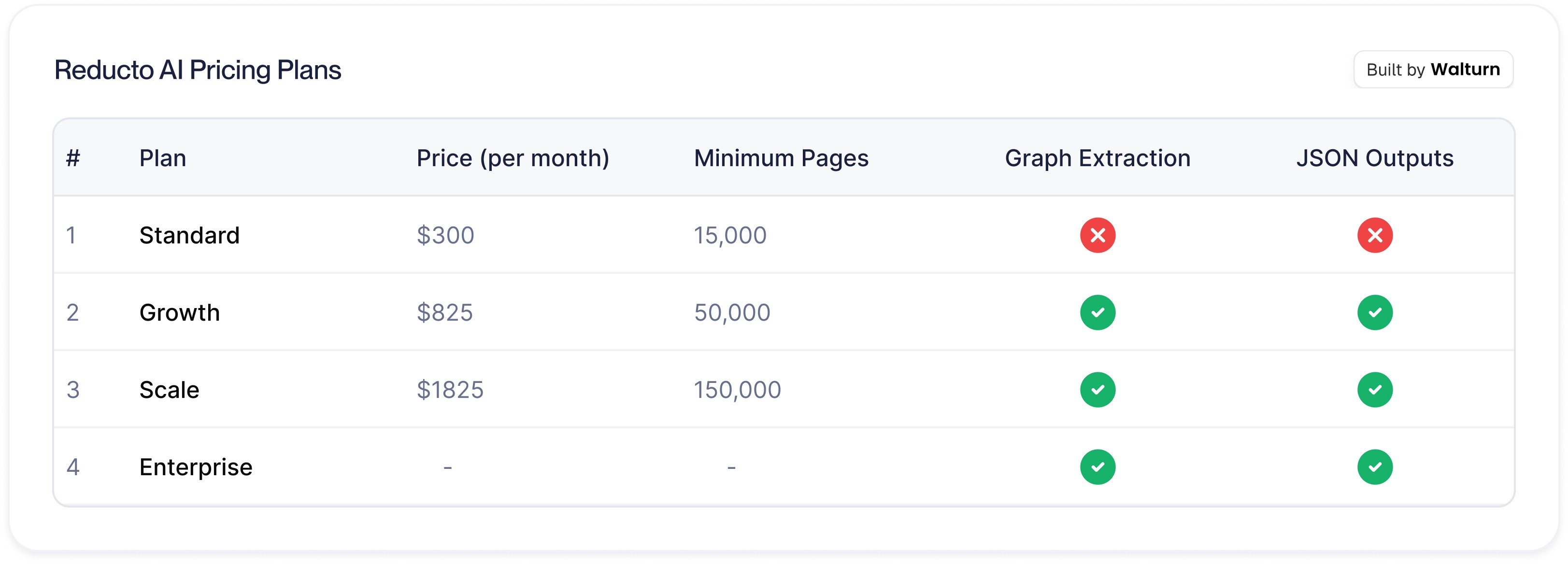Exploring Reducto AI and Similar Platforms
Summary
Reducto is a tool that enables data ingestion for a wide range of industries. It specializes in converting unstructured documents into structured, actionable input for LLMs, and provides direct interaction to retrieve information. Furthermore, this article discusses alternatives to Reducto that provide slightly different solutions for varying needs.
Key insights:
Understanding Data: Reducto categorizes data into two main types: unstructured and structured. Unstructured data requires manual effort to extract specific information, whereas structured data is organized in a way that allows for easy searching or indexing, enabling quick retrieval of data.
Costs of Unstructured Data: Managing unstructured data can be costly, starting with the significant storage requirements. Additional costs come from the time spent manually searching through data and the potential for errors in the process.
Data Retrieval: Reducto enables users to index ingested data, making information retrieval fast and efficient. It provides the quoted data along with the source file and any relevant context.
LLM-Compatible Outputs: Reducto offers outputs tailored to training LLMs on custom data, making it valuable for companies looking to build locally-trained LLMs.
Compliance: Compliance challenges often arise when dealing with unstructured data due to its difficulties in identifying files containing sensitive information. Reducto automates the process by identifying sensitive information.
Introduction
Industries like healthcare and finance are powered by data, where accessing and organizing unstructured information can feel like searching for a needle in a haystack. Reducto.ai tries to solve this problem. This Artificial Intelligence (AI) tool effectively extracts data from documents (including PDF and other formats) and transforms it into a structured actionable format. By converting unorganized data into clear insights, Reducto helps professionals and AI models make sense of complex information, enabling better decision-making.
This article provides a comprehensive overview of Reducto and aims to broaden the reader's understanding of the problems Reducto solves.
Structured vs. Unstructured Data
Reducto.ai assists users in converting unstructured data into structured data. Unstructured data is any information that may hold significant value on its own but requires interpretation and may take time to understand and organize. Examples of unstructured data include medical images and lab reports, which usually hold immense value but are frequently mixed up and hence waste time for the professional to find the data they are looking for.
Structured data, however, is organized and allows faster access to the required information. Examples include databases and spreadsheets that will enable the user to search for the required information.
Reducto provides structured bits of information from unstructured data that could be used to train Large Language Models (LLMs). While modern LLMs are generally capable of handling unstructured data, the effectiveness of their understanding can be improved with appropriate preprocessing. Reducto parses unstructured data and creates the connections necessary for LLMs to properly understand the information at hand.
The Purpose
The founders of Reducto, Adit, and Raunak, were confronted with a problem most businesses face today. Manual data extraction and entry are time-consuming and labor-intensive processes because the inconsistent and unstructured nature of the data makes it difficult to efficiently analyze and interpret.
Below are some issues connected with unstructured data and Reducto's attempt at solving these problems:
1. Storage
Unstructured data requires larger storage spaces and sophisticated solutions, which may be costly and time-consuming to implement. Moreover, even with the deployment of such solutions, there is no guarantee of readily available and efficient access to specific information when it is needed. The concern is further complicated by the inclusion of images, tables, and other forms of data that might make it more difficult to understand what the data represents.
Structured data from Reducto can easily be configured to separate important information from large documents, which could help save storage. The removal of noise also makes accessing certain parts of the data more efficient.
As an added benefit, all data on Reducto.ai is stored on Amazon Web Services (AWS) S3, which uses Advanced Encryption Standard (AES-256) to encrypt the data (server-side). AES-256 was approved by the National Security Agency (NSA) to protect government information, which makes it the ideal choice to meet compliance requirements. Nevertheless, even with reducto.ai, users would need to establish best practices for handling data and ensuring unauthorized individuals do not have access to sensitive information.
2. Error-Prone
The need for manual data entry usually arises to arrange data in a form that could provide faster access to the relevant information. For example, in a hospital setting, manual data entry from a patient’s previous medical records may be required to separate irrelevant information, leaving behind only the data required for the task at hand - saving time in the long run.
However, the issue is twofold. First, the initial data entry process itself consumes a significant amount of time that could have been invested in more productive tasks. Second, manual data entry is inherently vulnerable to human errors, which compromises the accuracy of the data and impacts the decisions made based on that information.
Reducto aims to solve both of these issues. The sophisticated preprocessing techniques employed by the tool can parse documents at very high speeds, potentially saving a considerable amount of time. Moreover, as an AI-powered solution, Reducto aims to eliminate the risk of human error. While the tool may still occasionally make misinterpretations, the frequency of such errors will likely be significantly lower compared to data entry. To further improve its responses, Reducto provides references to the sources of all information it presents, including page numbers and file names, which can be used to double-check and verify the data.
3. Compliance
Organizations need to adhere to legal requirements that ensure the protection of sensitive information. Compliance requirements, such as the GDPR and HIPAA, may vary across countries and industries. One of the most significant challenges with unstructured data is the lack of categorization, which makes it difficult for organizations to determine which data needs to be protected.
Categorizing data can significantly help organizations achieve compliance by allowing them to identify and prioritize sensitive information. By properly categorizing and tagging data based on its sensitivity level, organizations can ensure that appropriate security measures are applied to each category.
Furthermore, Reducto offers HIPAA-compliant pipelines for scale and enterprise-tier customers to ensure that all data sent through the system is sufficiently encrypted and protected against unauthorized access. Reducto is also currently in the process of obtaining SOC 2 Type 2 compliance, further enhancing the security of client data on the platform. As an additional layer of protection, all data is stored on AWS, which is compliant with regulations in both the United States and the European Union.
4. LLM compatibility
Unstructured data, which is often in the form of PDFs and other file formats, requires significant preprocessing before it can serve as input for LLMs. Reducto addresses this challenge by cleaning provided data and transforming it into structured formats like HTML, XML, or JSON, which are optimized for LLM inputs. By providing LLMs with structured data, Reducto streamlines the process and significantly improves the quality of the training data. Moreover, Reducto’s ability to handle text, graphs, and images sets it apart as a comprehensive solution for managing structured data.
5. Time-consuming
According to the official Reducto blog, the average employee spends about 10% of their time copying and pasting content roughly 1000 times per week. This time could be better invested in more productive activities, and manual data entry is prone to errors that could lead to poor decision-making.
Reducto solves this problem by automating these tasks through their API, which organizations can use to efficiently delegate the work to the AI tool. This automation also minimizes the risk of human error, ensuring accurate and reliable data for decision-making. The API also allows organizations to incorporate Reducto into their existing workflows, making the transition smooth and efficient.
Putting It All Together
Reducto challenges the conventional methods of handling unstructured data. By combining advanced algorithms that understand unstructured data “like a human” with a powerful language model, Reducto simplifies the extraction and identification of important data.
1. Intelligent Document Understanding
Reducto’s unique approach to document understanding sets it apart from other solutions. As explained by its cofounder, Adit, in a YouTube video, the tool identifies various blocks of information within a document, such as headers, images, and text, and processes each type through a dedicated pipeline. This allows Reducto to analyze the data comprehensively, including visual elements, to gain a complete understanding of the document’s content.
2. Data Retrieval and Integration
Once Reducto has analyzed the data, users can interact with the language model to retrieve the required information in various formats. The AI tool provides the source and reference for the extracted data, ensuring transparency and accuracy. Furthermore, Reducto’s ability to output data in formats like JSON and HTML allows users to integrate the data into various applications such as web interfaces and AI tools.
3. Use Cases
Organizations that heavily rely on unstructured data can benefit immensely from Reducto’s capabilities. By automating the discovery, organization, and protection of data, Reducto saves valuable time and resources that would otherwise be spent on manual data entry and analysis. Here are some sample use cases of Reducto:
Retrieval-Augmented Generation (RAG): Redcuto acts as a Retrieval-Augmented Generation system, allowing users to retrieve specific information from provided files, along with valid references to the original data sources. This approach offers an advantage over traditional LLMs, which are prone to hallucinations. By supplying only the information it has been fed, along with the references, Reducto improves the overall accuracy of its outputs - leading to better decision-making.
Financial Decision-Making: Financial institutions can leverage Reducto to automate the generation of balance sheets, income statements, and other financial reports. By configuring Reducto to parse every document, separate financial information, and connect the tool with their accounting systems, businesses can automate their tasks.
Healthcare Data Management: Reducto can automate the extraction of clinical data from unstructured patient records. By processing PDFs and scanned documents, Reducto can feed Electronic Health Records (EHR) systems, improving patient care through accurate and quickly accessible data. Additionally, Reducto can parse clinical trial data from large sets of medical records or trial results, enabling researchers to analyze trends quickly and easily.
Enhancing LLM Training with Structured Data: Reducto’s ability to transform unstructured data into structured formats like HTML and JSON can significantly enhance the training of LLMs. By processing large amounts of unstructured data from various sources, Reducto provides comprehensive outputs that are optimized for LLM training. This leads to more accurate, reliable, and multimodal LLMs capable of handling use cases specific to the user’s requirements.
Pricing
Reducto offers four pricing plans to meet the needs of its customers. Each plan offers different features and can be customized to change the limit on the number of pages that Reducto will process per month.
1. Standard
The standard plan is the most affordable option for small businesses looking to test Reducto. It supports PDFs, images, and automatic table summaries but does not include structured JSON extraction, slides, excel, or graph support. The standard plan starts at $300/month for 15,000 pages.
2. Growth
The growth plan includes all features missing in the standard plan, such as structured JSON extraction, a dedicated Slack channel, and support for Excel, slides, and graphs. It starts at $825/month for 50,000 pages.
3. Scale
The scale plan is the most comprehensive option for larger enterprises requiring data extraction from numerous sources. It builds on the growth plan, adding zero data retention agreements, SOO and SAML authentication, and HIPAA-compliant pipelines. It starts at $1825/month for 150,000 pages.
4. Enterprise
The enterprise plan allows businesses to create a custom plan that includes any options they require. The price and number of pages are negotiated directly with the Reducto team.

Alternatives to Reducto AI
Reducto targets a relatively new market and hence does not have many competitors. Some alternatives are introduced below.
1. Scale
Scale helps large organizations fine-tune their generative AI tools. The company primarily focuses on generating high-quality data to be used for fine-tuning other AI models. The tool does not have a definitive price range and any services would have to be negotiated with their sales team. It does however primarily focus on larger enterprises and government institutions with large amounts of data, and may not be completely affordable for a smaller business.
2. SpaCy
SpaCy is an open-source Python library for Natural Language Processing (NLP), known for its efficiency and accuracy in tasks like information extraction and text processing. While it can easily be integrated into workflows at no additional cost, spaCy lacks built-in support for processing graphs and images, which may be a limitation for organizations relying heavily on visual data.
3. Apache Spark
Apache Spark is a powerful open-source data processing framework known for its ability to handle large volumes of data efficiently. One of its key advantages is that it performs data processing in memory, which makes it significantly faster than disk-based alternatives. The in-memory processing capability suits Spark for processing massive datasets, such as transaction logs, that need to be streamlined and analyzed quickly. However, since Spark uses memory intensively, it may leave little room for other operations on the system, especially when dealing with extremely large datasets.
4. Docparser
Docparser allows users to extract data from Word, PDF, and image-based documents. It further allows users to set parsing rules, which are a set of simple instructions that tell the Docparser engine what information it should extract. Furthermore, it offers support for several common documents including invoices, purchase orders, bank statements, and form-based contracts among others.
Much like Reducto, the structured data can then be exported in various formats such as CSV, Excel, JSON, and XML files. This can be used in a wide array of use cases, such as filling out custom databases or training LLMs. Docparser offers even more features, including a version control system that can be used to maintain past copies of parsers. Docparser is also more affordable than Reducto starting at $32.50/Month allowing up to 1200 Parsing credits. 1 parsing credit allows the user to process 1 document with up to 5 pages.
In addition to all the above, Docparser is also GDPR-compliant and takes measures to ensure that all user data is adequately encrypted. All the data on Docparser is stored on AWS, which is also compliant with regulations in various countries and encrypts all data with AES-256.
5. Amazon Textract
Amazon Textract goes beyond simple optical character recognition (OCR) to identify and understand the data presented to it. It aims to eliminate the need for manual labor by automatically scanning all aspects of the document at hand and turning the data into a structured form. It offers support of several formats including PDFs, images, tables, and forms, where it also extracts handwriting for smoother processing.
Textract further allows its users to automatically identify key-value pairs from forms, which can then be retrieved accurately from the source. Users can also customize the pre-trained “Queries” feature, which can then lead to increased accuracy. It supports various languages including English, German, French, and more.
The pricing varies considerably depending on the needs of the user. Textract does however offer the most flexibility along with a free tier version that comes with certain limitations.
6. Google Document AI
Google’s Document AI provides the capabilities to extract, classify, and split structured data from documents. Google minimizes the configuration needed to run the service, making it easier to use. Along with the usual features that all other services provide, Google lets its users take advantage of years of OCR research at Google and supports data extraction in more than 200 languages. It also offers the top handwriting recognition in 50 languages, along with the ability to identify math formulas and font styles.
Google offers compliance with regional and industrial regulations. Google offers some of the most extensive security measures in the industries for both data at rest and in transit. All the data on Google Cloud is encrypted with AES-256 with Transport Layer Security (TLS) to encrypt data in transit.
The pricing varies significantly according to the customer's requirements, and Google also offers $300 worth of credit to new customers.
7. Rossum
Rossum specializes in transactional documents and makes it possible for data extraction from these to be completely automated. It receives the documents from various channels, including email, which is then filtered out to remove duplicates and spam. It extracts data from those documents and converts them into a structured format, which can be retrieved in a format that complies with the standard procedures of the business. Rossum complies with ISO 27001 and SOC 2 which shows their dedication to privacy and protection. The data is stored on AWS and protected with AES-256.
Rossum offers various plans including, Starter, Business, Enterprise, and Ultimate. The prices however have to be negotiated with the sales team and will depend on the individual use case.
Likewise, it is apparent from the tools mentioned above, that Reducto is not the only option for the specific task of data ingestion. Several other alternatives do claim faster performance, more language support, and better encryption. When compared to free alternatives, Reducto offers better automation and takes away the need for manual configuration, which makes it simpler and more efficient. However, alternatives like Amazon Textract and Google Document AI offer more affordable solutions with better performance.
Overall, Reducto offers a comprehensive solution to data ingestion with its support for data retrieval, data ingestion, and its understanding of graphs and images. Various alternatives do individually provide some of that functionality, but Reducto differentiates itself by eliminating the need to use it in conjunction with another tool. Lastly, images are an important part of most official workflow and not many solutions offer support for images, which might prove to be a major setback. The option often available is to extract text from images, which might not be enough for certain customers. Reducto builds on top of that with an ability to retrieve the needed image in a very short amount of time along with an integrated LLM for interactions, which makes it stand out.
Conclusion
In conclusion, the recent trend toward AI tools requires data ingestion capabilities for organizations to make information more accessible. Many businesses are exploring AI-powered solutions such as locally trained chatbots to deliver precise information. This highlights the importance of tools like Reducto AI, which structure raw data in ways that enhance LLM comprehension. By integrating Reducto or similar alternatives, businesses can improve the reliability and performance of their LLMs. However, each tool has its own strengths and limitations, requiring organizations to carefully select one that matches their requirements.
Authors
Maximize Your AI Potential with Walturn
Are you leveraging unstructured data for AI-driven insights? Walturn can guide you in selecting and implementing the right tools like Reducto to transform your data for efficient processing. Let us help you optimize your workflows and accelerate AI development with expert consultation.
References
Adit. “- YouTube.” Youtu.be, 2024, youtu.be/hB6LfIUfKNc?si=tmbT-IiW_MoQ472z. Accessed 30 Aug. 2024.
Adit and Raunak, Co-Founders of Reducto. “Reducto Document Ingestion API.” Reducto.ai, 2024, reducto.ai/blog/document-api. Accessed 30 Aug. 2024.
“AI Document Processing for Transactional Workflows.” Rossum.ai, 9 Sept. 2024, rossum.ai/document-processing/. Accessed 10 Sept. 2024.
Amazon Web Services. “Protecting Data Using Server-Side Encryption - Amazon Simple Storage Service.” Docs.aws.amazon.com, docs.aws.amazon.com/AmazonS3/latest/userguide/serv-side-encryption.html.
“Amazon Textract | Extract Text & Data | AWS.” Amazon Web Services, Inc., 2019, aws.amazon.com/textract/.
“Amazon Textract FAQs | AWS.” Amazon Web Services, Inc., 2024, aws.amazon.com/textract/faqs/.
“Amazon Textract Features | AWS.” Amazon Web Services, Inc., 2024, aws.amazon.com/textract/features/.
“Customer Success Story: Cohere | Scale AI.” Scale.com, scale.com/customers/cohere.
Denitsa Stefanova. “Data Encryption: Importance, Best Practices, IT Compliance.” LogSentinel, 29 July 2020, logsentinel.com/data-encryption-importance-best-practices-it-compliance/. Accessed 7 Sept. 2024.
“Docparser Features - Powerful Data Capture & Automation.” Docparser, docparser.com/features/.
“Document AI.” Google Cloud, cloud.google.com/document-ai.
“Encryption at Rest in Google Cloud | Documentation.” Google Cloud, cloud.google.com/docs/security/encryption/default-encryption
“Encryption in Transit in Google Cloud | Documentation.” Google Cloud, cloud.google.com/docs/security/encryption-in-transit.
Fedor Moiseev, et al. SKILL: Structured Knowledge Infusion for Large Language Models. 1 Jan. 2022, https://doi.org/10.18653/v1/2022.naacl-main.113.
“Generative AI Solutions for Enterprise.” Scale.com, 2024, scale.com/enterprise/generative-ai-solutions. Accessed 8 Sept. 2024.
“Intelligently Extract Text & Data with OCR - Amazon Textract Pricing - Amazon Web Services.” Amazon Web Services, Inc., aws.amazon.com/textract/pricing/.
JanbaskTraining. “What Is Spark? Apache Spark Tutorials Guide & Ecosystem Components, Features.” JanbaskTraining, 13 Apr. 2018, www.janbasktraining.com/blog/what-is-spark/.
Kiteworks. “Everything You Need to Know about AES-256 Encryption.” Kiteworks | Your Private Content Network, 2023, www.kiteworks.com/risk-compliance-glossary/aes-256-encryption/.
“Platform Overview.” Rossum.ai, rossum.ai/platform/.
“Pricing.” Rossum.ai, 5 Sept. 2024, rossum.ai/pricing-plans/.
Reducto, Team. “The Real Cost of Manual Document Processing.” Reducto.ai, 2024, reducto.ai/blog/the-real-cost-of-manual-document-processing. Accessed 30 Aug. 2024.
Reducto.ai. “Security.” Reducto, 2024, docs.reducto.ai/docs/security-1. Accessed 31 Aug. 2024.
“Security and Trust.” Rossum.ai, 4 June 2024, rossum.ai/intelligent-document-processing/security-and-trust/.
“Security Statement.” Docparser, 9 Oct. 2023, docparser.com/security/.
Shenwai, Dhanshree Shripad. “Meet Reducto: An AI-Powered Startup Building Vision Models to Turn Complex Documents into LLM-Ready Inputs.” MarkTechPost, 11 Aug. 2024, www.marktechpost.com/2024/08/11/meet-reducto-an-ai-powered-startup-building-vision-models-to-turn-complex-documents-into-llm-ready-inputs/. Accessed 31 Aug. 2024.
spaCy. “SpaCy 101: Everything You Need to Know · SpaCy Usage Documentation.” SpaCy 101: Everything You Need to Know, 2016, spacy.io/usage/spacy-101.
Turing. “Data Processing for LLMs: Techniques, Challenges & Tips.” Www.turing.com, www.turing.com/resources/understanding-data-processing-techniques-for-llms.
Ycombinator. “Reducto: Unlocking Data behind Complex Documents | Y Combinator.” Y Combinator, 2024, www.ycombinator.com/companies/reducto. Accessed 31 Aug. 2024.

















































